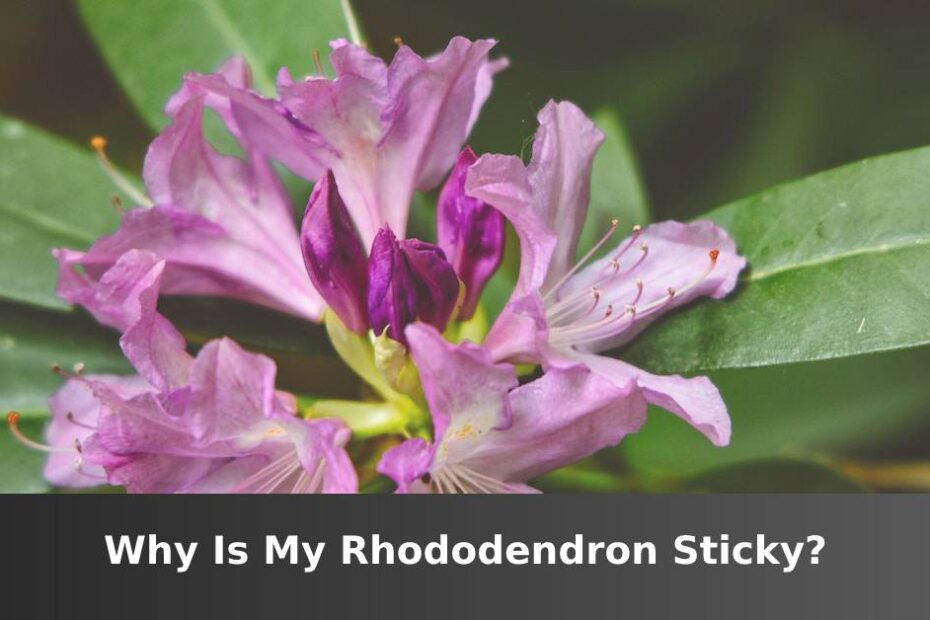If you’ve gotten to the point where you’re wondering, why is my Rhododendron sticky, the short answer is that you most likely have a pest problem.
There are certain types of pests that love to get ahold of Rhododendron’s and feed on the leaves causing all sorts of damage.
The main thing about these pests is they leave behind a sticky substance known as honeydew which is most likely the reason for sticky leaves on your Rhododendron.
Possible signs of pests
Pests can cause all sorts of issues other than just your Rhododendron being sticky, and often times the pests are so small you will notice the signs before the bugs themselves.
Here are some other signs that you could have a pest problem.
- Holes in the leaves
- Sticky leaves
- Leaves are drooping
- Stunted growth
- Yellowing of the leaves
- Brown leaves or tips
- Black leaves or spots
- Bumps on the leaves or stems
- White leaves or spots
- Leaves falling off
As you can see there are many signs of symptoms of a pest problem and honestly, your Rhododendron being sticky is one of the more mild issues compared to most.
Although, honeydew eventually turns into sooty mold and who want’s that?
I don’t and I’m sure you don’t either.
Pests you may be dealing with
Below are some types of pests your Rhododendron may be currently dealing with to give you an idea of what to look for and how to identify them.
Aphids
Aphids are small (1/16-1/8 inch) pear shaped pests that can range in color from green, red, black, brown or colorless.
They often are found on the leaves and in clusters too unfortunately so they can cause quite the stir on your Rhododendron.
They are also made to feed on the leaves sap, causing nutrient loss in plants which causes a lot of the symptoms listed above.
When they’re done, they will excrete the honeydew which is responsible for your Rhododendron being sticky or the leaves being more sticky than usual.
Scale
Scale pests are a bit larger than aphids (1/8-1/2 inch) so they are much easier to spot and are often mistaken as just bumps on branches.
Scale bugs are usually black or brown and like to hangout on the branches and undersides of the leaves, but they will also feed on the leaves sap as well.
Once again they will leave behind that honeydew responsible for your sticky Rhododendron which eventually turns into sooty mold.
Even worse, there are normal scale bugs and then there are armored scales, sounds like fun(joke).
Whitefly
Whitefly bugs are somewhere in the middle on size (1/16-1/10 inch) and look just like the name, they look like white flies.
Unfortunately you guessed it, they love to feed on the leaves sap, causing all sorts of issues and then to top it off, they leave behind that annoying honeydew.
One interesting thing about dealing with whiteflies specifically, they are attracted to the color yellow so yellow sticky traps can be used to get them off of your Rhododendron.
The more you know.
How to deal with them
As you can see, those are only a few different kinds of pests that can be causing your Rhododendron to become sticky.
In any case, the way to get rid of the pests is pretty much the same for most types of pests.
You can try a few different things to get rid of them as seen below.
- Water with some light pressure to spray them off
- Use a cotton swab dipped in rubbing alcohol to wipe down the leaves
- Insecticidal soap can be sprayed onto the plant to eliminate the bugs
- Neem oil can be sprayed to get rid of them and help keep them away
Those are some of the ways you can get rid of most pests which is needed to not only help stop the leaves from being sticky, but to ensure the health of your Rhododendron.
When you first notice pests, make sure to isolate your plant first before applying treatment so the bugs don’t spread by the way.
For a more comprehensive guide on pests, you should check out my article how to get rid of bugs on Rhododendrons.
How to get rid of the honeydew
You really don’t want the honeydew substance to be hanging around for too long as it will turn into sooty mold and ruin the aesthetics of your Rhododendron.
Fortunately, honeydew can be easily removed from your Rhododendron by simply using warm water and a cloth to wipe down the plant.
If the honeydew has already turned into sooty mold, it will start to fade away on it’s own one the honeydew itself is gone, or you can apply horticultural oil to help speed the removal process.
Closing thoughts
So there you have it, if you were wondering why is my Rhododendron sticky, now you know that honeydew from pests is to blame.
Overall I hope you learned something new today so you can keep your Rhododendron looking and growing it’s best no matter what happens!
